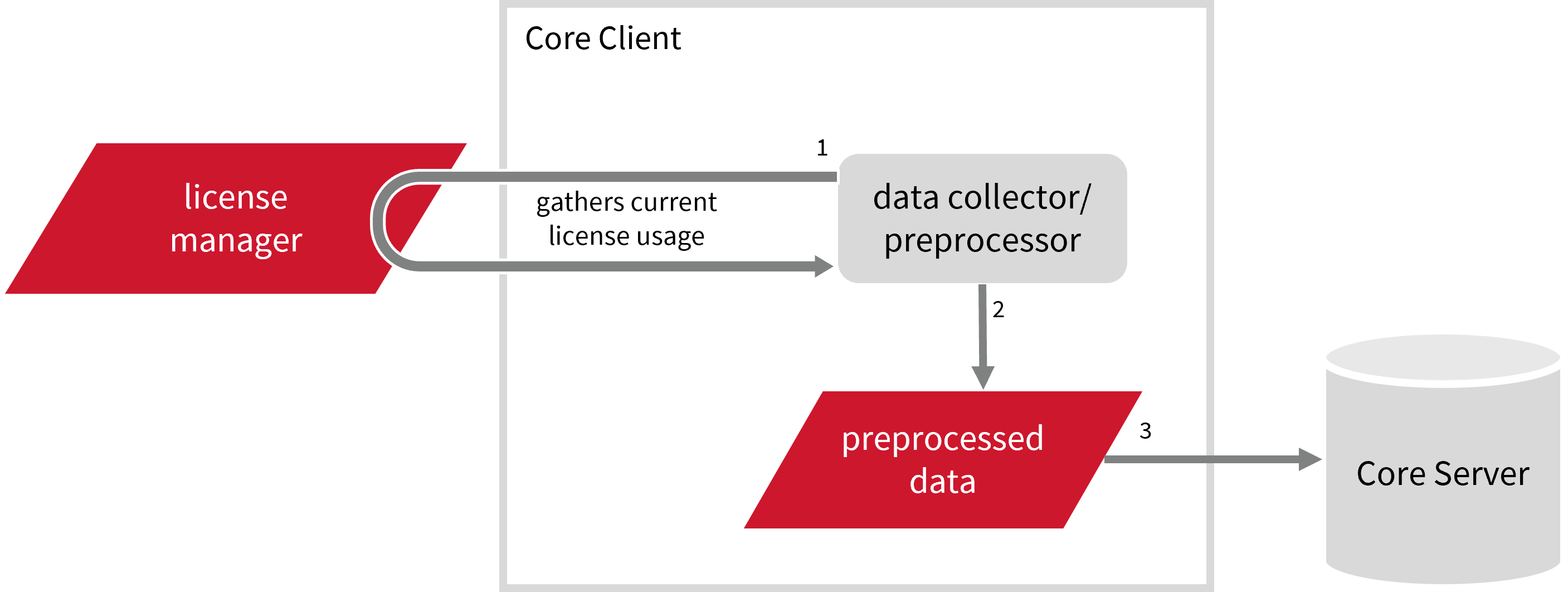We’re upgrading your documentation experience!
A new doc website is live at docs.openit.cloud — a temporary preview during our transition. This website is now in maintenance-only mode (only critical issues will be addressed).
Explore the new website and send us your feedback!
#
V-Ray License Manager
#
Introduction
Open iT supports V-Ray usage reporting by polling the license servers at regular intervals to get the current status of its license use and availability.
An Open iT client is installed on your license server for this collection. The data collector/preprocessor gathers the current license usage information from the license manager every 5 minutes, triggering the data collection process. It also processes the gathered license usage. Once the data is preprocessed, it is transmitted to the Core Server, according to the client's timezone, for further storage, completing the license usage data collection and processing.

This will produce the following aggregated data types used for historical reporting:
- (131) V-Ray License Usage
- (132) V-Ray License User Concurrency
There are three(3) supported license models:
- Online - licenses that can be used when online
- Offline - licenses that a user can use offline for two(2) weeks
- Dongle - licenses that are available through a USB license dongle attached to a workstation/server
The following sections will guide you in setting up the necessary configuration to collect and send the required data to the server.
Apply the configurations shown in the Open iT client.
#
Requirements
- An Open iT Client connected to an Open iT Server or a coexistent Open iT setup
- License server administrative rights
- License server hostname and port
#
Configuring Raw Data Collection
These are the required steps to activate and configure collection of raw V-Ray data.
Open a command prompt with Administrator level privileges.
Go to the bin directory, which is by default in
C:\Program Files\OpeniT\Core\bin, run the command:Command Syntaxcd $BIN_DIRExamplecd C:\Program Files\OpeniT\Core\binOnce in the directory, activate the collection of V-Ray poll data, run the command:
Command Syntaxopenit_oconfinit -u "collect_license_vray-polls.root.scheduler.jobs.collect_vray.general.active=true"Set the hostname and port of your V-Ray server, run the command:
Command Syntaxopenit_oconfinit -u "collect_license_vray-polls.root.scheduler.jobs.collect_vray.operations.arguments=--key vray --target \"${OpeniT.directories.temp}/PollCollector/VRay\" --interval PT5M --timeout PT5M --module license --datatype vray --skip-onerror --exe \"${OpeniT.directories.bin}/openit_vraystat\" --args --server \"<hostname>\" --port \"<port_number>\" --retry \"2\" --timeout \"10\""where:
<hostname>is the hostname of your V-Ray server<port_number>is the port number of your V-Ray server
Exampleopenit_oconfinit -u "collect_license_vray-polls.root.scheduler.jobs.collect_vray.operations.arguments=--key vray --target \"${OpeniT.directories.temp}/PollCollector/VRay\" --interval PT5M --timeout PT5M --module license --datatype vray --skip-onerror --exe \"${OpeniT.directories.bin}/openit_vraystat\" --args --server \"host557\" --port \"30304\" --retry \"2\" --timeout \"10\""
Go to the bin directory, which is by default in
/opt/openit/bin, run the command:Command Syntaxcd $BIN_DIRExamplecd /opt/openit/binOnce in the directory, activate the collection of V-Ray poll data, run the command:
Command Syntax./openit_oconfinit -u "collect_license_vray-polls.root.scheduler.jobs.collect_vray.general.active=true"Set the hostname and port of your V-Ray server, run the command:
Command Syntax./openit_oconfinit -u "collect_license_vray-polls.root.scheduler.jobs.collect_vray.operations.arguments=--key vray --target \"${OpeniT.directories.temp}/PollCollector/VRay\" --interval PT5M --timeout PT5M --module license --datatype vray --skip-onerror --exe \"${OpeniT.directories.bin}/openit_vraystat\" --args --server \"<hostname>\" --port \"<port_number>\" --retry \"2\" --timeout \"10\""where:
<hostname>is the hostname of your V-Ray server<port_number>is the port number of your V-Ray server
Example./openit_oconfinit -u "collect_license_vray-polls.root.scheduler.jobs.collect_vray.operations.arguments=--key vray --target \"${OpeniT.directories.temp}/PollCollector/VRay\" --interval PT5M --timeout PT5M --module license --datatype vray --skip-onerror --exe \"${OpeniT.directories.bin}/openit_vraystat\" --args --server \"host557\" --port \"30304\" --retry \"2\" --timeout \"10\""
The collection runs every 5 minutes. To configure the intervals, locate the instances attribute under collect_vray, preprocess_vray, transfer_vray_parsed, or transfer_vray_raw in the same file and configure the attributes.
Refer to the V-Ray Poll Job Scheduler Instances Configuration table to learn the attributes used to configure V-Ray data collection and transfer.
#
Verifying Data Collection
After configuration, you can verify that the data is collected and sent to the server by following these steps:
Open a command prompt with Administrator level privileges.
Go to the bin directory, which is by default in
C:\Program Files\OpeniT\Core\bin, run the command:Command Syntaxcd $BIN_DIRExamplecd C:\Program Files\OpeniT\Core\binRun the command:
Command Syntaxopenit_executor -r collect_license_vray-pollsVerify that there are
archiver*.infiles created in the server in the archiver directory, which is by default inC:\ProgramData\OpeniT\Data\incoming\archiver.
Go to the bin directory, which is by default in
/opt/openit/bin, run the command:Command Syntaxcd $BIN_DIRExamplecd /opt/openit/binRun the command:
Command Syntax./openit_executor -r collect_license_vray-pollsVerify that there are
archiver*.infiles created in the incoming directory in your defined data_dir($ROOT_DATA_DIR)upon Open iT server installation.
#
Next Steps?
Renaming Vendor License Renaming Features Create and Add Report License Monitor

